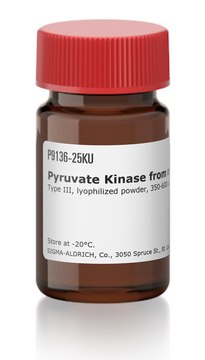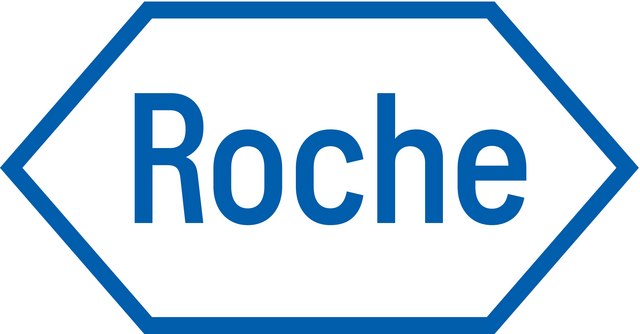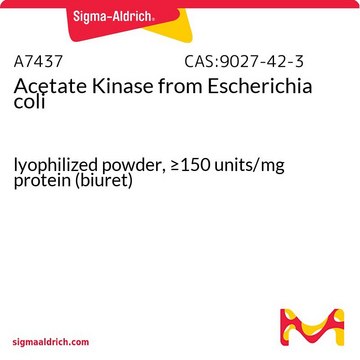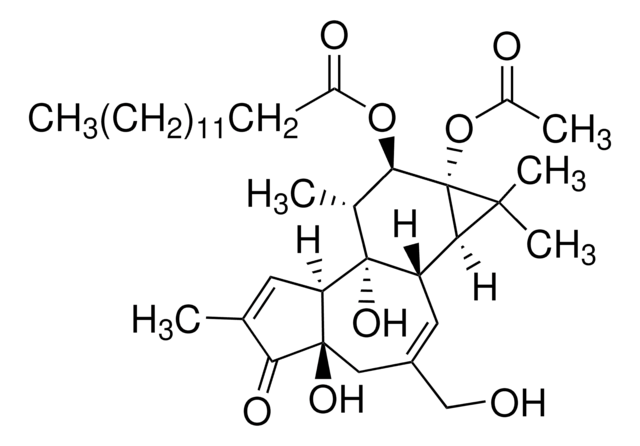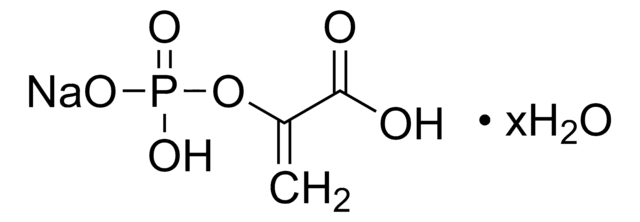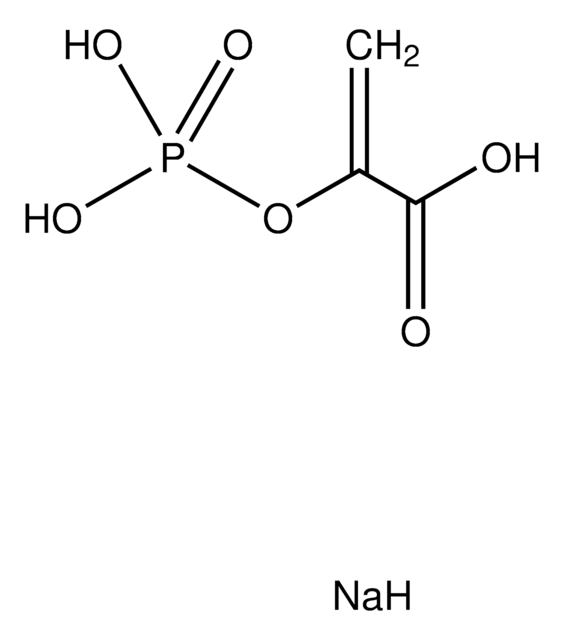P1903
Pyruvate Kinase from Bacillus stearothermophilus
Type VIII, lyophilized powder, 100-300 units/mg protein
Synonyme(s) :
ATP:pyruvate 2-O-phosphotransferase, PK
Se connecterpour consulter vos tarifs contractuels et ceux de votre entreprise/organisme
About This Item
Produits recommandés
Source biologique
Bacillus sp. (B. stearothermophilus)
Niveau de qualité
Type
Type VIII
Forme
lyophilized powder
Activité spécifique
100-300 units/mg protein
Température de stockage
2-8°C
Description générale
Research Area: CELL SIGNALING
Mammalian pyruvate kinase is a tetrameric protein composed of identical subunits organized in a dimer-of-dimers configuration. Four isoforms of pyruvate kinase exist in mammals, namely PKM1, PKM2, PKR, and PKL. Pyruvate kinase can be found in both tetrameric and dimeric forms.
Mammalian pyruvate kinase is a tetrameric protein composed of identical subunits organized in a dimer-of-dimers configuration. Four isoforms of pyruvate kinase exist in mammals, namely PKM1, PKM2, PKR, and PKL. Pyruvate kinase can be found in both tetrameric and dimeric forms.
Application
Pyruvate Kinase from Bacillus stearothermophilus may be used in biofuel production.
Pyruvate kinase from Bacillus stearothermophilus has been used in a study to assess evidence that the genes for phosphofructokinase and pyruvate kinase constitute an operon. It has also been used in a study to investigate the importance of the Lys221 active site for pyruvate kinase activity.
Actions biochimiques/physiologiques
Pyruvate Kinase from Bacillus stearothermophilus is activated by AMP and ribose 5-phosphate.
Pyruvate kinase is an enzyme that facilitates the conversion of phosphoenolpyruvate (PEP) and ADP to pyruvate and ATP in glycolysis and is involved in the regulation of cell metabolism. It serves as a terminal enzyme in the glycolytic pathway. This reaction is favorable due to the high energy of hydrolysis of PEP.
Pyruvate kinase is a key regulator controlling metabolic flux and ATP production in glycolysis and is considered a potential drug target. Additionally, pyruvate kinases are subject to regulation by heterotropic effectors, with fructose 1,6-bisphosphate (FBP) being the most widely known allosteric activator of bacterial, yeast, and mammalian enzymes. Furthermore, PKM2, one of the four isoforms of pyruvate kinase, is extensively expressed in various types of tumors and is associated with tumorigenesis.
Pyruvate kinase is a key regulator controlling metabolic flux and ATP production in glycolysis and is considered a potential drug target. Additionally, pyruvate kinases are subject to regulation by heterotropic effectors, with fructose 1,6-bisphosphate (FBP) being the most widely known allosteric activator of bacterial, yeast, and mammalian enzymes. Furthermore, PKM2, one of the four isoforms of pyruvate kinase, is extensively expressed in various types of tumors and is associated with tumorigenesis.
Définition de l'unité
One unit will convert 1.0 μmole of phospho(enol)pyruvate to pyruvate per min at pH 7.2 at 30 °C.
Forme physique
Lyophilized powder containing Tris buffer salts, pH 8.5
Remarque sur l'analyse
Protein determined by biuret
Code de la classe de stockage
11 - Combustible Solids
Classe de danger pour l'eau (WGK)
WGK 3
Point d'éclair (°F)
Not applicable
Point d'éclair (°C)
Not applicable
Équipement de protection individuelle
Eyeshields, Gloves, type N95 (US)
Faites votre choix parmi les versions les plus récentes :
Déjà en possession de ce produit ?
Retrouvez la documentation relative aux produits que vous avez récemment achetés dans la Bibliothèque de documents.
Les clients ont également consulté
Notre équipe de scientifiques dispose d'une expérience dans tous les secteurs de la recherche, notamment en sciences de la vie, science des matériaux, synthèse chimique, chromatographie, analyse et dans de nombreux autres domaines..
Contacter notre Service technique